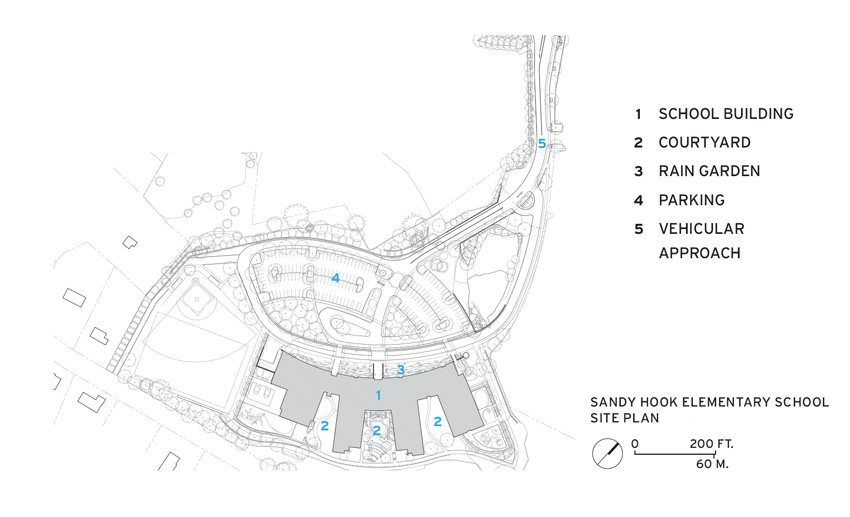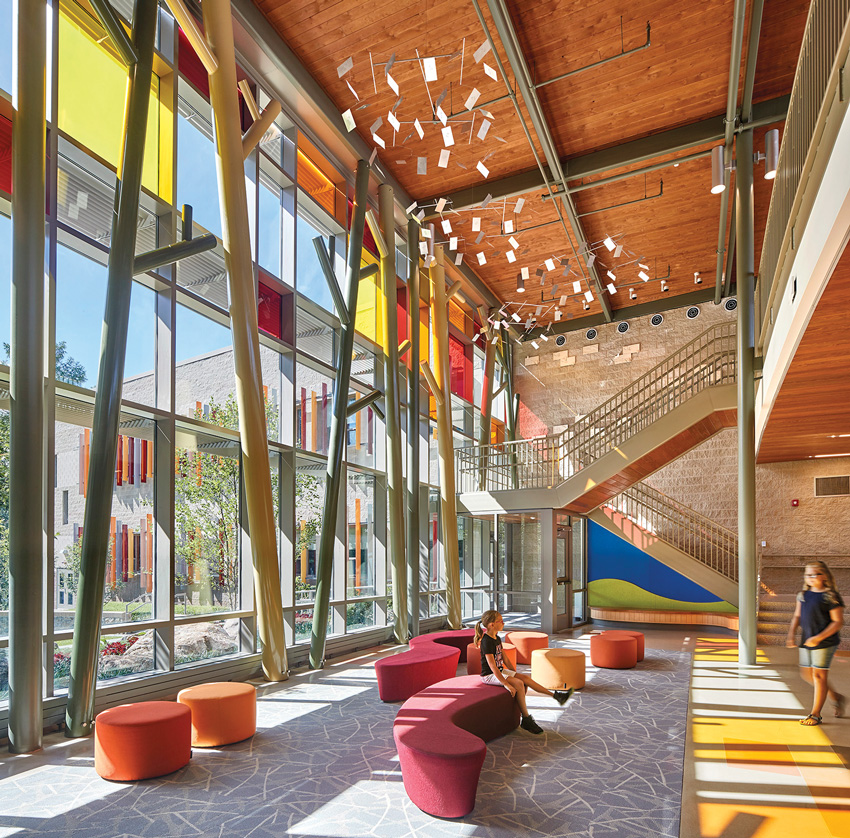School Safety and Security
Learning Objectives:
- Outline the crime-deterrent principles of CPTED.
- Explain how the designers of the new Sandy Hook Elementary School made its security features inconspicuous.
- Discuss how schools can be designed to mitigate the impact of natural disasters, including tornadoes and floods.
- Describe the role that biophilic design can play in making schools feel safer for students.
Credits:
View course on architecturalrecord.com »
This course is part of the Education Academy
December 14 was the fourth anniversary of the Sandy Hook Elementary School massacre in Newtown, Connecticut, the most lethal in America’s sad history of mass shootings of schoolchildren. That history is now unfolding at an average of about two shootings at K–12 schools per month: more rare than death by lightning, but still too frequent. More commonplace threats are fights and bullying. And even on an ordinary day, with no immediate or looming danger, the fundamental challenge of being a school kid navigating the ups and downs of life in a sea of other school kids can feel more fraught than it needs to be.


PHOTOGRAPHY: © ROBERT BENSON
MODERN-DAY MOAT
To enter the new Sandy Hook Elementary School, people must cross one of three pedestrian bridges that span a rain garden (top).
Design can’t solve all that, but it can make a difference. Here we look at three schools—an elementary school and two high schools—that address multiple aspects of safety and security, and illustrate how architects can improve the chances that children do not become victims at school.
No matter how intense the concern for security, a bunker is not the answer. This was the message that emerged from a community consultation process that informed the design for the new Sandy Hook Elementary School by New Haven, Connecticut–based Svigals + Partners (RECORD, September 2016, page 27). The school, now in its first year of operation, replaces the one demolished following the 2012 shooting tragedy in which 20 children and 6 staff members died. “The priority is making a nurturing environment for the future generations of this town. You can’t let it all be colored by this horrific, terrible incident,” says Jay Brotman, managing partner at Svigals. “We didn’t have to say that; the community said it.”
The new 87,000-square-foot, $50 million school translates the town’s priorities of vitality, community, and connection to nature into a building that feels bright, open, and playful. A curving plan extends a seeming embrace as students approach. Gables emerge from behind the facade’s undulating roofline: this is intended to recall views of the town, in which buildings and spires extend above the trees. A daylit, art-filled interior provides a cheerful, engaging environment, and ample windows look out to an adjacent forest.
The security strategies are incorporated so unobtrusively that visitors touring the school have commented that they don’t see them. “That’s high praise, when in fact security has been designed into almost every aspect,” says Brian Coulombe, a principal with Hamden, Connecticut–based security consultant DVS, a division of Ross & Baruzzini. The key, he says, is establishing security as a design priority from the outset. “When we’re brought in late in the game, the tools left in our toolbox dwindle” and projects have to resort to more add-on electronic devices, staffing, and physical barriers to compensate, he says.
In achieving its inconspicuous security, Sandy Hook’s designers drew on the principles of Crime Prevention Through Environmental Design (CPTED), a multidisciplinary approach to deterring criminal behavior. CPTED builds on the work of 20th-century thinkers such as Jane Jacobs, Oscar Newman, and C. Ray Jeffery, and relies on architectural design, landscape planning, security systems, and visual surveillance. CPTED’s main principles include “natural surveillance,” which gives legitimate users opportunities in the course of their ordinary activities to keep an eye on the place and the people around them; “natural access control,” which directs users to enter through observable areas and prevents access to unobservable areas; and “territorial reinforcement,” which encompasses a variety of strategies for signaling that a place is occupied and cared for. Together, CPTED strategies generate psychological and physical deterrents.
The Sandy Hook design team’s first step in providing for natural surveillance was to set the building toward the rear of its site, so that anyone approaching the school can be observed from a distance. Windows, which in a fortress mentality would be considered a vulnerability, become an asset. Inside, a two-story glazed entrance lobby provides views into one of three semi-enclosed courtyards where children play and learn outdoors. Inverting the concept of natural surveillance in order to deprive an intruder of an advantage, classroom windows and doors are located so that occupants can shelter unseen by someone in the corridor.


PHOTOGRAPHY: © ROBERT BENSON
NATURAL PLAYSCAPE
At Sandy Hook, two-story glazed entry lobbies (bottom) look out onto semi-enclosed courtyards where children can play and learn outdoors (top).
The siting of the school was also the first step in natural access control. Wetlands and forest provide physical barriers to the sides and rear of the building, and anyone approaching from these directions draws suspicion. The main route brings all users toward the front, where staff, visitors, parent drivers, and school buses are funneled to dedicated approaches. Along the main facade, a rain garden reinforces natural access control: in addition to managing stormwater runoff and providing a teaching opportunity, it serves as a modern-day moat, directing people to enter by one of three pedestrian bridges and making it difficult to approach the building’s windows unobserved. Supplementing the site’s natural barriers are territorial-reinforcement devices including fencing and security gates.
Once the passive design for security is maximized, says Brotman, “you look to technology to reinforce or fill in the gaps.” So Sandy Hook’s entry vestibule complies with the State of Connecticut’s new school-security guidelines’ requirement for bullet-resistant glass, while other strategic locations throughout the school, such as corridor walls, have been hardened against attack. Cameras enhance the control of the courtyards, classroom doors have automatic locks, and an alert sounds if an exit stair door is left ajar. Most security incidents are over in less than five minutes, “so the real issue is to delay a perpetrator until the first responder arrives,” says Brotman.









